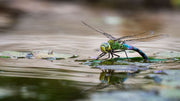
You built a pond for peace and beauty—yet mosquitoes breed in the shallows, and your water feature still feels lifeless. If you’ve ever watched a dragonfly hover like a jeweled helicopter and wished it would make your garden home, good news: encouraging these aerial acrobats is easier than you think. Dragonflies devour hundreds of mosquitoes daily, add dazzling movement, and signal a balanced ecosystem. This guide shows how to attract dragonflies with the right plants, water design, and pond-safe gear from Poposoap—so you can spend summer evenings listening to the splash of a fountain, not swatting bugs.
Why Dragonflies Belong in Your Pond

Dragonflies are apex insect predators. As adults, they patrol the air, intercepting gnats, flies, and midges; as aquatic nymphs, they hunt mosquito larvae, tadpoles, and even small fish fry. Welcoming them means fewer pests and a healthier food web for frogs, birds, and bats. Because dragonflies need clean, still-to-slow-moving water for at least several months of their life cycle, a well-managed garden pond is an ideal nursery.
Poposoap’s brand vision—creating moments of joy while protecting the world we share—aligns perfectly with dragonfly conservation. Their solar-powered fountains and biological filters aerate and clarify water without chemicals, giving larvae the oxygen-rich habitat they need.
The Life Cycle of a Dragonfly

Understanding the life cycle helps you design a welcoming environment.
- Eggs
- Females tap their abdomens on emergent vegetation or submerged stems, inserting eggs that hatch in one to three weeks.
- Aquatic Nymph (6 months to 4 years)
- Nymphs breathe through abdominal gills, lurking among roots and leaf litter. They require dissolved oxygen and refuge from fish.
- Emergence
- When ready, the nymph climbs a sturdy stem above the water, splits its exoskeleton, and unfurls wings—transforming into the dazzling adult that fascinates us.
- Adult (a few weeks to several months)
- Adults hunt over water and meadows, mate, and repeat the cycle.
Each stage demands specific habitat features: shallow planting ledges, vertical stems, clean water, and sunlit perches.
What Attracts Dragonflies to Ponds

Dragonflies are selective. They choose ponds that offer:
- Sunlight – Warm water speeds larval growth; shady, overhung pools receive fewer visits.
- Varied Depths – Shelves at 6 inches, 12 inches, and 24 inches let both nymphs and plants thrive.
- Gentle Circulation – A low-flow fountain such as the Poposoap Floating Pond Fountain ripples the surface enough to oxygenate without turning the pond into a swift stream that sweeps away larvae.
- Absence of Pesticides – Insecticides kill nymphs outright; herbicides eliminate the vegetation adults use for egg-laying.
- Safe Zones – Caves or dense plants offer hiding spots from larger fish.
When you design with these needs in mind, dragonflies will find you.
Best Pond Plants That Attract Dragonflies

Choosing the right flora is the single most effective strategy for anyone googling what plants attract dragonflies or plants to attract dragonflies.
- Pickerelweed (Pontederia cordata) – Emergent spikes give egg-laying sites and bloom purple all summer.
- Arrowhead (Sagittaria spp.) – Broad leaves shade nymphs; stout stems act as emergence ladders.
- Blue Flag Iris (Iris versicolor) – Vertical swords offer perfect molting posts and vivid spring color.
- Water Horsetail (Equisetum fluviatile) – Dense stands provide cover from predatory fish.
- Dwarf Bulrush (Scirpus cernuus) – Fine, grassy texture shelters tiny larvae.
- Hardy Water-lilies (Nymphaea cultivars) – Floating pads calm the surface, letting adults rest between patrols.
Plant in clusters on tiered shelves for a natural look. Avoid invasive cattails that can crowd out other species.
Pond Design Tips to Welcome Dragonflies

- Keep One-Third Shallow. Dragonfly nymphs hunt best in 6–12 inches of water; include a pebble beach or shelf.
- Add Vertical Texture. Place driftwood or decorative reed bundles so emerging adults can climb clear of the water.
- Use Biological Filtration. Install a Poposoap Solar Pond Filter to remove excess nutrients naturally. Clear water lets nymphs sight prey and reduces algal blooms that rob oxygen.
- Provide Gentle Aeration. Pair the solar filter with a Poposoap Solar Pond Aerator overnight; quiet bubbles sustain oxygen without creating turbine-like currents.
- Illuminate, Don’t Blind. Dragonflies are diurnal, but subtle lighting extends viewing hours for you and deters nighttime mosquito swarms. Soft-glow Poposoap Warm White Solar Pond Lights highlight plants without disorienting wildlife.
- Limit Predatory Fish. Koi are beautiful yet voracious; keep numbers moderate and supply plant thickets where nymphs can hide.
These tweaks transform any ornamental pool into a dragonfly sanctuary—and they align with Poposoap’s eco-centric philosophy.
Avoid Chemicals That Harm Dragonflies
(Use Poposoap pond-safe filtration to support wildlife)
Chemical algaecides and broad-spectrum insecticides annihilate larvae before they ever lift off. Instead:
- Rely on mechanical and biological filtration—like Poposoap’s pond filter kits with integrated coarse pads, activated carbon, and bio-balls—to clear green water.
- Shade the surface with lilies rather than copper sulfate.
- Skim leaves weekly; decaying organics breed algae and deplete oxygen.
- Spot-treat string algae manually or with barley extract, which is benign to invertebrates.
By keeping the water column balanced naturally, you support both dragonflies and the broader pond community.
Benefits of Attracting Dragonflies

- Mosquito Control. One adult can eat 100 mosquitoes a day, and each nymph feeds on larvae below.
- Biodiversity Boost. Healthy dragonfly populations indicate clean water, which benefits snails, frogs, and songbirds.
- Dynamic Beauty. Healthy dragonfly populations indicate clean water, which benefits snails, frogs, and songbirds.
- Educational Value. Children can observe metamorphosis up close—much more vivid than any textbook learning.
- Pesticide Reduction. Natural predation means fewer sprays, aligning with sustainable gardening goals.
When guests inquire about the source of the dragonfly appeal and why your garden buzzes with activity, you'll attribute it to considerate planting, conscious design, and unobtrusive technology like the Poposoap Floating Pond Fountain that circulates water without scaring off delicate larvae.
Final Thoughts
Dragonflies require no stocking like koi; they will come on the breeze the instant your pond offers clean water, sunny perches, and verdant edge planting. Foster those conditions—supported by Poposoap's solar filtration and wildlife-friendly lighting—and your summer soundtrack will change from mosquito whines to the hum of jeweled wings. Nature takes care of the rest.
Ready to build a dragonfly paradise? Check out eco-friendly fountains, filters, and lighting at Poposoap and follow the Poposoap family on Instagram, YouTube, and Facebook for everyday pond inspiration.







